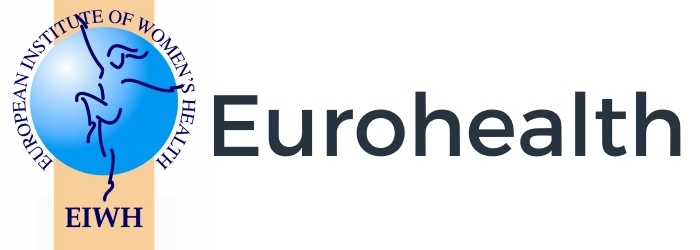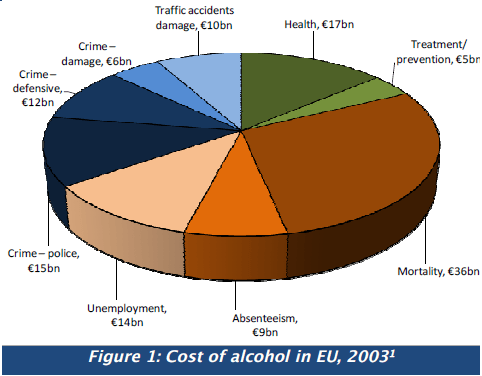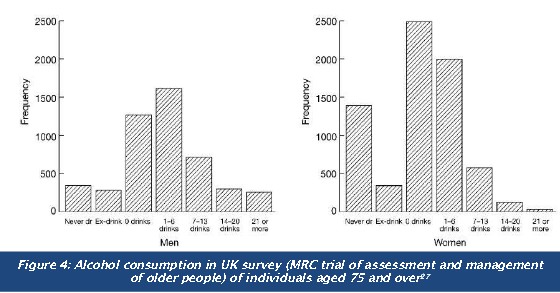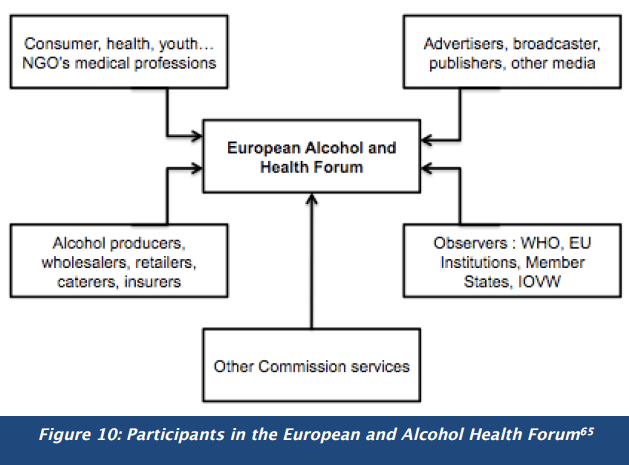 Policy Brief
Policy Brief
European Institute of Women’s Health
Women and Alcohol in the EU
Download as .doc | .pdf | .mp3
Women and Alcohol in the EU: The Basics
Europe is the heaviest drinking region in the world, with the average European consumption accounting for twice that of the global alcohol intake. Over 1/5 of the European population aged 15 and older binge drink at least once a week. Alcohol is the third leading risk factor for disease and death after tobacco use and high blood pressure. Globally, the European Region has the highest proportion of ill health (7%) and early death due to alcohol.(3,4,5)
The consumption of alcohol is a complex issue. On the one hand, alcohol has been part of Europe’s culture and everyday life in many countries. In this regard, it is considered a means of socialising, relaxing and celebrating pleasurable life events and is often part of the local food culture. On the other hand, imprudent or excessive alcohol consumption can cause addiction and ill health. Alcohol consumption can endanger one’s own life or that of others through risky behaviour, such as causing traffic accidents, aggressive behaviour unsafe sex, rape and unwanted pregnancy. Alcohol consumption during pregnancy can harm the unborn child.
Various issues surround alcohol consumption throughout Europe. Large cross national variation exists with regard to drinking cultures. A study of 17,000 people found that alcohol habits in Europe are changing. Nevertheless,certain trends are evident across Europe. Traditional wine drinking countries, like Italy and France, are now experiencing a rise in beer consumption.
There is also a significant trend towards drinking excessively. Young adults in Europe are drinking less often than their parents and grandparents; yet, when they drink, they are consuming much larger quantities than previous generations.(8)
Alcohol Related Disease: Why Gender Matters
Historically, women have consumed alcohol less often and in lower amounts than men. However, over time, the changing societal role of women and lessening of social taboos have led to a rise in the frequency and level of alcohol consumption among women
- Increasingly, young women in Europe are becoming more frequent binge drinkers. (9,10) In recent years, Europe’s women have benefited from a longer lifespan than men, outliving them by an average of 5 years. However, some studies warn that women’s increased tobacco and alcohol consumption is set to narrow the gender gap in avoidable illness and death over time. (11,12)
Women have different drinking patterns from men, and alcohol affects women and men differently. For women, alcohol consumption is in many ways more dangerous than it is for men, making them particularly vulnerable to alcohol’s harmful effects. Women also appear to become addicted to alcohol more quickly than men. Women due to their smaller body size, higher body fat and lower water content experience double the alcohol concentration in their blood stream compared to men drinking the same amount of alcohol. The bodies metabolise alcohol is also different. Therefore, women are more at risk even while drinking less alcohol than men. Moreover, alcohol related health issues start sooner in women than men. Overall, women are more susceptible to alcohol dependency, liver cirrhosis and tissue damage than men. (13,14)
Alcohol consumption is connected to over 60 diseases and health issues. Women do not need to consume as much alcohol as men to run the same risk as men for certain diseases
Increased alcohol consumption is linked to increased risk for conditions such as acute pancreatitis, cardiovascular disease, breast cancer, liver cancer, liver cirrhosis and various mouth and throat cancers. For example:a man who drinks six standard drinks daily is 13x more likely to:
develop cirrhosis of the liver compared to a non drinker; while a woman who drinks only four standard drinks daily has the same cirrhosis risk. Heavy drinking also puts women at risk of injuries and death from car accidents, falls, self harm and unsafe sex. (15)
Alcohol and Breast Cancer
Alcohol increases women’s risk of breast cancer. The relationship between alcohol and cancer is strong. However, many women are unaware of this link between drinking and breast cancer, one of the cancers that women fear most. It is estimated that one in five breast cancer deaths in the EU is attributable to alcohol. One standard alcoholic drink taken daily, increases breast cancer risk by 9%, while 3-6 drinks daily, raises it dangerously by 41%.(16)
The Dangers of Binge Drinking in Young Women
There is no universally accepted definition of binge drinking. According to the Institute of Alcohol studies in the UK, “ drinking surveys normally define binge drinkers as men consuming at least eight, and women at least six standard units of alcohol in a single day, that is, double the maximum recommended ‘safe limit’ for men and women respectively.”(17)>Rates of youth drinking and binge drinking, as well as society’s acceptance of these trends,are increasing throughout the EU. Easy access to alcohol, coupled with other behavioural and social factors, have led to increased rates of youth drinking in both males and females.Significant variations exist throughout the EU in binge drinking among youth and young adults. Teenage binge drinking has reached rates of 60% in Denmark, 57% in Germany, 54% in the UK, 34% in Italy, and 28% in France.(18)
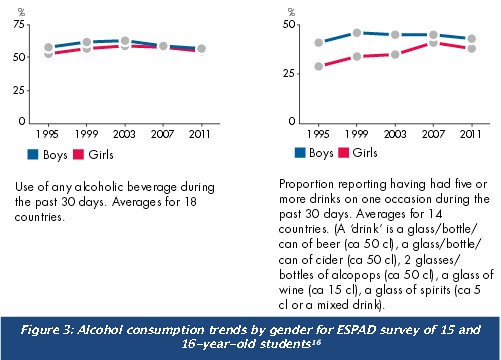
The 2011 European School Survey Project on Alcohol and other Drugs (ESPAD), surveyed 15 and 16 year olds in 36 European countries. The survey shows that “heavy episodic drinking” in the last 30 days has increased most in young girls with averages up from 29% in 1995 to 41% in 2007. Alarmingly,the gender gap has shrunk on average from 12% in 1995 to 5% in 2011 with regard to binge drinking among youth. Swedish girls had significantly higher binge drinking rates compared to boys. In other countries such as Finland, the UK, Ireland, France, Belgium and Estonia, there is no gender gap in student binge drinking.Excessive alcohol consumption takes its death toll on the young; annually, more than 55,000 people between the ages of 15-29 in Europe die from alcohol related road accidents, poisoning, suicides and murders.(20) Young women particularly in Eastern Europe are seen by the alcohol industry as a potential growth market. The industry targets them by pushing “healthy” alcohol products.(21)
The Danger of Alcohol Consumption in Older Women
Research on drinking among older people remains limited.(22) Yet, older women are particularly vulnerable to alcohol problems as they are more likely than men to outlive their partner, experience other losses, become frail and/or financially dependant. These circumstances can cause loneliness and depression.(23)
Biologically, women are more susceptible to the adverse effects of increased alcohol consumption compared to men. Older women have less lean muscle mass and lose more with ageing, making them more vulnerable to the effects of alcohol. As people age, liver enzymes that process alcohol and medicines become less efficient, and central nervous system sensitivity increases.(24)
Interaction of Alcohol with Medicines
As older women take more over the counter and prescription medicines, alcohol use combined with medications is particularly dangerous for them. It can be responsible for confusion, falls, self neglect and lead to loss of independent living. It is therefore recommended that older women reduce their alcohol consumption to lower levels than those for younger women and older men. (25)
The potential co-morbidity of alcoholism and depression in older women remains a neglected area that urgently needs to be addressed. Generally, older women drink less than older men or may abstain from alcohol consumption altogether. However, often the issue of alcohol use by older women remains hidden. Social care workers, health professionals or family members are less likely to identify risky alcohol consumption and drinking issues among older women.
In addition, older women are less likely than older men to seek specialised addiction treatment, making it difficult to effectively identify and support them with alcohol preventive measures.(26)
Alcohol and Pregnancy
The EU Alcohol Strategy prioritises the protecting of young people, and unborn children from harm. Drinking alcohol during pregnancy is the leading known cause of birth defects and child developmental disorders, affecting about 1% (5 million) people in the EU. Nevertheless, many pregnant women continue drinking, with rates in Europe ranging from 25% in Spain to 79% in the United Kingdom and Ireland.(29)
Alcohol is much more dangerous to the unborn child than to the mother. When a pregnant woman drinks alcohol, it passes via the mother’s blood through the placenta to the baby. Within minutes the baby’s blood alcohol level reaches that of the mother. However, as alcohol needs to be processed by the unborn child’s not yet fully developed liver, it can create life-long damage to the health of the child.
The most serious conditions are Foetal Alcohol Spectrum Disorders (FASD) which are caused by the mother drinking alcohol during pregnancy.(30) It is important that women know that FASD is preventable by abstaining from drinking alcohol during pregnancy. Alcohol consumption during pregnancy endangers the infant’s physical and mental health and is associated with a wide spectrum of disorders:
Behavioural problems (including increased risk of being easily distracted with low attention span and slow reaction times)
- Birth defects (heart, brain and other organs)
- Learning disabilities (including intellectual disabilities)
- Pre term birth
- Sleeping and sucking problems
- Speech and language delays
- Vision or hearing problems (31, 32, 33)
There is currently no scientific consensus about the level of drinking during pregnancy at which damage occurs to the unborn child. (34) Because the amount of alcohol required to cause foetal damage is still under debate, most public health guidelines recommend total abstention. (35)
The UK Chief Medical Officer advises, “Women who are pregnant or trying to conceive should avoid alcohol altogether. However, if they do choose to drink, to minimise the risk to the baby, we recommend they should not drink more than 1-2 units once or twice a week and should not get drunk.”(36)
Such messages can be confusing for some women, especially since ‘the unit’ measure is not clearly defined and open to interpretation. France, with its longstanding tradition as a wine drinking country, has led the way with an example of good practice. Since October 2006, the French Code of Public Health requires a warning label on alcohol packaging: “ Consumption of alcoholic beverages during pregnancy even in small amounts can seriously damage the child’s health.”(37) The warning is accompanied by an easy to grasp visual logo (see Figure 5)
The best advice to give women is:
Stay away from alcohol when planning to
become pregnant and during pregnancy
Marketing to Women
Following the example of the tobacco industry, the alcohol industry increasingly targets their promotional activities at women to increase their market. Around 2.2% of their new product s are aimed at women, compared to 1.1% at men. For instance, in the UK, Coors has a department focusing on beer development and marketing towards women with the aim to create “ a world where women love beer as much as they love shoes .” (46, 47)
Recently alcohol advertising has targeted women by marketing certain alcohol beverages to women, such as alco pops, spirits and wine. These products typically have a high alcohol content. Products historically consumed by men such as beer are increasingly also being marketed to women. About 25% of beer consumption can be attributed to women.(48,49)
Alcohol marketing to women uses a variety of techniques such as TV programme sponsorship, fashion blogs, social media and special events like girls’ nights in/out. Companies promote alcohol to increase brand awareness and to get female customers to personally connect with the product. For example, in Ireland, one company depicts Thursdays as the girls’ night out, setting up beauty bars, giving fashion advice and offering free drinks.(50)
Alcohol companies are developing products specifically for women such as fruit flavoured beer to deal “with the factors which make beer unattractive to women: taste, smell, and the fairy tale that beer makes fat” (Van den Berg, Heineken Netherlands). Heineken published an advertisement for its drink Wieckse Rosé in Pink Magazine that encouraged increased funding for breast cancer research and awareness, despite the link between alcohol consumption and breast cancer.(51, 52)
“Light” products appeal to women who are conscious of their weight and calorie consumption. Famous actresses are deployed as spokes persons for various female targeted alcohol beverages in order to portray drinks as glamorous and sophisticated. Different techniques are employed to target various subsets of women through clever marketing strategies appealing to younger and older women. For example, to appeal to younger women, companies are depicting attractive men in sexually suggestive advertisements. Other advertisements depict women mimicking historically male behaviour while enjoying beer to show that women can “keep up with the boys.” (53, 54)
Policy Intervention: Pricing, Taxation and Labelling
Alcohol is a major contributor to the EU economy. In 2001, alcohol excise duties alone amounted to €25 billion in the EU15. (56) Research indicates that increase in alcohol prices decreases overall alcohol consumption. Studies suggest that the most effective alcohol policy comprises control on alcohol pricing and availability, drink driving laws and intervention for people with drinking issues.(57)
As alcohol has become increasingly affordable in recent years, many public health experts recommend minimum pricing as cheap prices can encourage over-consumption. (58)
Labelling is intended to provide the consumer with information such as ingredients and nutritional values, but also usefully warn about the product’s health risk, such as during pregnancy (see section on page 3). There is currently much debate around the cut – off alcohol content point that allows exemption from product ingredients and nutritional information labelling requirements.(59)
Mandating warning labels on alcoholic beverages has been politically difficult to achieve in some European countries. In February 2012, for instance, the National Substance Misuse Strategy Steering Group published a report that recommended that labels be put on alcohol products sold in Ireland containing health warnings about drinking during pregnancy. Over a year later, no such labels have been added to packaging.(61,62)
Women and Alcohol in the EU – Drink Driving
Reducing injuries and deaths from alcohol related road accidents is a main priority of the European Alcohol Strategy. In the EU, drink driving results in 17,000 accidents and 10,000 deaths annually. Of these 17,000 accidents, there is a large gender differential: 15,000 accidents can typically be attributed to men and about 2,000 to women. In the EU, alcohol causes 30-40% of driver deaths, and ¼ of all road traffic deaths. About 2-3% of car trips in the EU are associated with an illegal Blood Alcohol Limit (BAC).(63)
Drink driving among women is rising, reflecting women’s changing habits. Men and women have different drinking preferences, and women metabolise alcohol differently than men. Women reach a higher level of blood alcohol concentration than men, when the amount is adjusted for body weight. This means that the same amount of alcohol has a greater effect on woman. Little robust comparable European data is currently available about drink driving. Based on UK data, from 1995 to 2004, there was a 58% rise in women convicted of driving while under the influence of drink or drugs. During the same period, there was 0.25% decline in men convicted of similar offenses. Nearly 1 in 3 convictions of women for drink driving were for under the age of 30. Government officials in the UK stated that anti-drink driving campaigns historically targetted men. However, changing statistics indicate that public health approaches need to be modified to be gender sensitive.(64)
EU Alcohol Strategy (2006-2012)
Following the Council Recommendations, the EU Commission initiated the European Alcohol
Strategy, which is supported by the stakeholders of the European Alcohol and Health Forum.
The Strategy identifies the following 5 priority themes considered relevant in all member states:
- Protect young people,children and the unborn child;
- Reduce injuries and death from alcohol-related road accidents;
- Prevent alcohol – related harm among adults and reduce the negative impact on the workplace;
- Inform, educate and raise awareness on the impact of harmful and hazardous alcohol consumption, and on appropriate consumption patterns;
- Develop and maintain a common evidence base at EU level.(66)
The European Alcohol and Health Forum (EAHF), set up to help implement the Alcohol Strategy, brings together members from public and private member organisations (see Figure 5) who are invited to collaborate to combat alcohol related – harm. EAHF has various workgroups to focus on the EU Alcohol Policy’s Priorities: the Taskforce on youth – related aspects of alcohol, the Taskforce on marketing communication,and the Science Group. (67)
A first progress report was published in late 2009 and the Strategy is currently under review by DG SANCO. It is expected that tax and pricing will remain under national purview.(68)
The EU Alcohol Strategy is supported by three collaborative initiatives. The WHO Regional Office for Europe and the Commission carry out joint surveys of trend s and developments in alcohol consumption, alcohol – related harm and alcohol – related policies across the EU.(69)
A Committee for national alcohol policy and action brings together government representatives to exchange information, knowledge and best practice on reducing alcohol consumption and related harm.
RAYPRO (Resource on Alcohol and Youth Projects) is an online resource for sharing information and best practice to reduce alcohol – related harm among youth and children.(70)
EU Alcohol Strategy and Young People
Concerned with the prudent use of alcohol by young people, the European Council adopted a Recommendation in 2001 on the Drinking of Alcohol by Young People. This was supplemented with a Council Decision in 2006 to include the threat to older adults aged 60+, maternal health, as well as the harmful link between alcohol HIV/AIDS, and also TB. The European Alcohol Strategy invites the Commission to support Member States to reduce alcohol-related harm through research, policy and action against marketing and advertising to youth. It discusses concerns with regard to binge drinking and increased drinking among girls.(71) Nevertheless, trends illustrate that drinking among youth, particularly young women and girls continues to increase in Europe.
EU Alcohol Strategy (2006-2012)
Following the Council Recommendations, the EU Commission initiated the European Alcohol Strategy, which is supported by the stakeholders of the European Alcohol and Health Forum.
The Strategy identifies the following 5 priority themes considered relevant in all member states:
- Protect young people, children and the unborn child;
- Reduce injuries and death from alcohol-related road accidents;
- Prevent alcohol-related harm among adults and reduce the negative impact on the workplace;
- Inform, educate and raise awareness on the impact of harmful and hazardous alcohol consumption, and on appropriate consumption patterns;
- Develop and maintain a common evidence base at EU level.(66)
EAHF has various workgroups to focus on the EU Alcohol Policy’s Priorities: the Taskforce on youth related aspects of alcohol, the Taskforce on marketing communication, and the Science Group.(67) A first progress report was published in late 2009 and the Strategy is currently under review by DG SANCO. It is expected that tax and pricing will remain under national purview.(68)
The EU Alcohol Strategy is supported by three collaborative initiatives. The WHO Regional Office for Europe and the Commission carry out joint surveys of trend s and developments in alcohol consumption, alcohol related harm and alcohol related policies across the EU(69)
A Committee for national alcohol policy and action brings together government representatives to exchange information, knowledge and best practice on reducing alcohol consumption and related harm. RAYPRO (Resource on Alcohol and Youth Projects) is an online resource for sharing information and best practice to reduce alcohol related harm among youth and children. (70)
EU Alcohol Strategy and Young People
Concerned with the prudent use of alcohol by young people, the European Council adopted a Recommendation in 2001 on the Drinking of Alcohol by Young People. This was supplemented with a Council Decision in 2006 to include
- the threat to older adults aged 60+
- maternal health as well as
- the harmful link between alcohol HIV/AIDS, and TB.
The European Alcohol Strategy invites the Commission to support Member States to reduce alcohol related harm through research, policy and action against marketing and advertising to youth. It discusses concerns with regard to binge drinking and increased drinking among girls.(71) Nevertheless, trends illustrate that drinking among youth, particularly young women and girls continues to increase in Europe.
Steps for Policy Action
- Support and improve existing EU data collection to track alcohol consumption and its impact on women’s health. Annually collect data, disaggregated by gender and age, in order to fully understand trends in alcohol consumption. At the EU level, set up a robust comparable monitoring system to track alcohol consumption and misuse trends across the Member States.
- Increase awareness of the major issues, including how they relate to gender, surrounding alcohol consumption in Europe, particularly the alarming trends in youth alcohol consumption and binge drinking. Alcohol consumption, including binge drinking in young girls and women, is on the increase. Make women themselves and the public health community aware that alcohol consumption has disastrous consequences for women’s future health. Develop effective alcohol cessation campaigns targeted at girls and young women as a priority in all EU countries. Special treatment centres focusing on women and their specific problems are needed.
- Alcohol consumption during pregnancy constitutes a major health challenge for mother and unborn child. It can cause birth defects and Fetal Alcohol Syndrome in children. Tackle alcohol consumption in women before, during and after pregnancy, offering women support rather than blame. Agree to a new robust EU Alcohol Strategy and implement the Strategy speedily. The previous Strategy did not include taxation and minimum pricing; these issues should be more forcefully addressed as they largely impact behavioural and health trends related to alcohol consumption. Develop effective policies and enforce strict labelling and health warnings by the alcohol industry. Ban industry marketing practices that specifically target young girls, including certain brands such as ‘alco pops’ that entice young women into the drinking habit.
- Increase understanding of the damage that excessive alcohol consumption causes to both men and women. Consider different patterns, causes and mechanisms as to why men and women drink. Develop a comprehensive gender-sensitive strategy for prevention, diagnosis and treatment. Fund research into prevention, diagnosis and treatment of alcohol preventable diseases to better understand how women and men are differently affected by alcohol consumption. Develop effective gender sensitive guidelines and interventions to counteract alcohol consumption in women.
- Address the danger of alcohol consumption, alcohol use and medicine-taking in older people. Currently, there is little awareness about the hidden danger of a drinking in older people. Develop guidelines to address alcohol consumption and medicine taking in the next stage of the EIP—Action Plan for Healthy Active Ageing.
A special thank you to our expert reviewer
Mariann Skar, Secretary General, European Alcohol Policy Alliance
World Health Organization Global Strategy to Reduce Harmful Use of Alcohol
In May 2010, the 193 Member States of WHO adopted the Global Strategy to reduce the harmful use of alcohol. This strategy guides countries and the WHO Secretariat on ways to reduce the harmful use of alcohol.
Various aspects of the Strategy relate to young people and to women, specifically pregnant women. (72,73)
WHO calls for the following measures:
“Special attention needs to be given to reducing harm to people other than the drinker and to populations that are at particular risk from harmful use of alcohol such as:
- children and adolescents,
- women of child bearing age,
- pregnant and breastfeeding women,
- indigenous peoples and other minority groups or groups with low socioeconomic status.
- (74)Policy options and interventions should support “initiatives for screening and brief interventions for hazardous and harmful drinking at primary health care and other settings; such initiatives should include early identification and management of harmful drinking among pregnant women and women of child-bearing age” and reducing “the impact of marketing, particularly on young people and adolescents, is an important consideration in reducing harmful use of alcohol.”(75)
European Institute of Women’s Health
https://www.eurohealth.ie
References
1. WHO Europe. 2013. Status Report on Alcohol and Health in 35 European Countries.
European-Countries.pdf?ua=1.
2. Institute of Alcohol Studies (IAS). 2010. Alcohol & Health. .
3. WHO Europe. Alcohol Use: Facts and Figures. .
4. WHO Europe. 2012. Alcohol in the European Union: Consumption, harm and policy approaches. .
5. WHO Europe. 2012. European action plan to reduce the harmful use of alcohol 2012-2020.
6. Cohen, Adam. 2008. “Europe’s Changing Drinking Habits: More Beer, Less Wine, Fewer Regrets.” Wall Street Journal. http://online.wsj.com/article/SB122842679622780557.html.
7. International Center for Alcohol Policies (ICAP). 2013. ICAP Blue Book: 9. Alcohol and Women.
tabid/170/Default.aspx#1.
Bloomfield, K., Grittner, U., Kramer, S., & Gmel, G. 2006. “Social inequalities in alcohol consumption and alcohol-related problems in the study countries of the EU concerted action “Gender,
culture and alcohol problems: A multi-national study.” Alcohol and Alcoholism, 41, 26–36.
8. European Society of Cardiology. 2011. European women live longer than men, but not better. http://www.escardio.org/about/press/press-releases/esc11-paris/Pages/gender-gap-risk-factors.
aspx
9. Cohen, Adam. 2008. “Europe’s Changing Drinking Habits: More Beer, Less Wine, Fewer Regrets.” Wall Street Journal. http://online.wsj.com/article/SB122842679622780557.html.
10. Institute of Alcohol Studies (IAS). 2017. Alcohol and Women. http://www.ias.org.uk/Alcohol-knowledge-centre/Alcohol-and-women.aspx.
11. ICAP. 2013. ICAP Blue Book: 9. Alcohol and Women.
12. Alcohol Action Ireland. 2013. Women and alcohol: time for a rethink? http://alcoholireland.ie/policy/women-and-alcohol-time-for-a-rethink/.
13. Schutze, M., et al. 2011. “Alcohol attributable burden of incidence of cancer in eight European countries based on results from prospective cohort study.” BMJ 2011;342:d1584.
14. ICAP. 2013. ICAP Blue Book: 9. Alcohol and Women.
15. Breastcancer.org. Drinking Alcohol. http://www.breastcancer.org/risk/factors/alcohol.
16. IAS. 2010. Binge drinking—nature, prevalence and cause. Factsheet. .
17. Join Together. 2005. “Youth drinking worse in Europe than in US.”
18. European Monitoring Centre for Drugs and Drug Addiction. 2015. The 2015 ESPAD Report.
19. European Monitoring Centre for Drugs and Drug Addiction. 2011. Summary: 2011 ESPAD Report.
20. UNODC. 2011. Alcohol trends among youth in Europe. http://www.unodc.org/youthnet/youthnet_action_good_practice_alcohol_trends.html.
21. DG Health and Food Safety. Alcohol Policy. .
22. Institute of Alcohol Studies (IAS). 2017. Alcohol and Women. http://www.ias.org.uk/Alcohol-knowledge-centre/Alcohol-and-women.aspx.
23. European Alcohol Policy Alliance. 2009. Alcohol trends—markets and innovations. http://eurocare.org.
24. Ahlstrom, Salme. 2008. “Alcohol use and problems among older women and men: a review.” Nordic studies on alcohol and drugs. .
25. Blow, Frederic and Kristen Lawton Barry. 2003. Use and Misuse of Alochol Among Older Women. National Institute on Alcohol Abuse and Alcoholism. http://pubs.niaaa.nih.gov/publications/
arh26-4/308-315.htm.
26. Blow, Frederic and Kristen Lawton Barry. 2003. Use and Misuse of Alochol Among Older Women. National Institute on Alcohol Abuse and Alcoholism. http://pubs.niaaa.nih.gov/publications/
arh26-4/308-315.htm.
27. Blow, Frederic and Kristen Lawton Barry. 2003. Use and Misuse of Alochol Among Older Women. National Institute on Alcohol Abuse and Alcoholism. http://pubs.niaaa.nih.gov/publications/
arh26-4/308-315.htm.
28. Spencer, Ben. 2014. “Sharp rise in women over 60 treated for alcoholism: Number seeking help for drinking problems up 65% in five years.” The Daily Mail. http://www.dailymail.co.uk/health/
article-2837215/Sharp-rise-women-60-treated-alcoholism-Number-seeking-help-drinking-problems-65-five-years.html.
29. Blow, Frederic and Kristen Lawton Barry. 2003. Use and Misuse of Alochol Among Older Women. National Institute on Alcohol Abuse and Alcoholism. http://pubs.niaaa.nih.gov/publications
arh26-4/308-315.htm.
30. European Alcohol Policy Alliance (Eurocare). 2013. Alcohol and pregnancy. .
31. WHO Europe. 2016. Prevention of harm caused by alcohol exposure in pregnancy. http://www.drugsandalcohol.ie/26073/1/WHO_Prevention-harm-caused-alcohol-exposure-pregnancy.pdf.
32. O’Sullivan, Claire. 17 Jan 2017. “Ireland tops list for pregnant women drinking.” The Irish Examiner.
drinking-439408.html.
33. European Alcohol Policy Alliance (Eurocare). 2013. Alcohol and pregnancy. .
34. WHO Europe. 2016. Prevention of harm caused by alcohol exposure in pregnancy. http://www.drugsandalcohol.ie/26073/1/WHO_Prevention-harm-caused-alcohol-exposure-pregnancy.pdf.
35. European Alcohol Policy Alliance (Eurocare). 2013. Alcohol and pregnancy. .
36. IAS. 2008. Women and alcohol.
37. European Alcohol Policy Alliance (Eurocare). 2013. Alcohol and pregnancy.
38. March of Dimes. 2016. Alcohol during pregnancy. http://www.marchofdimes.org/pregnancy/alcohol-during-pregnancy.aspx.
39. March of Dimes. 2012. Alcohol and drugs. .
40. European Alcohol Policy Alliance (Eurocare). 2013. Alcohol and pregnancy.
41. NHS. 2012. Can I drink alcohol when I’m pregnant? http://www.nhs.uk/chq/Pages/2270.aspx?CategoryID=54#close.
42. ICAP. 2012. Health warning labels. .
43. WHO Europe. 2016. Prevention of harm caused by alcohol exposure in pregnancy. http://www.drugsandalcohol.ie/26073/1/WHO_Prevention-harm-caused-alcohol-exposure-pregnancy.pdf.
44. WHO Europe. 2009. Alcohol and Injuries. .
45. Ander, Peter and Ben Baumberg of the Institute of Alcohol Studies UK. Report for DG SANCO. 2006. Alcohol in Europe: A Public Health Perspective.
determinants/life_style/alcohol/documents/alcohol_europe.pdf.
46. Institute of Alcohol Studies. 2016. Domestic abuse, sexual assault, child abuse and violence.
abuse-sexual-assault-child-abuse-and-violence.aspx.
47. DG Communication. 2010. Domestic Violence Against Women. .
48. Institute of Alcohol Studies. 2016. Domestic abuse, sexual assault, child abuse and violence.
abuse-sexual-assault-child-abuse-and-violence.aspx.
49. WHO Europe. 2005. Alcohol and interpersonal violence. .
50. WHO Europe. 2009. Alcohol and Injuries. .
51. Institute of Alcohol Studies. 2016. Domestic abuse, sexual assault, child abuse and violence.
abuse-sexual-assault-child-abuse-and-violence.aspx.
